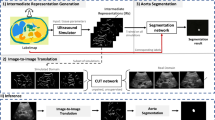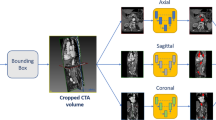Abstract
Purpose
Artery contrasted computed tomography (CT) enables accurate observations of the arteries and surrounding structures, thus being widely used for the diagnosis of diseases such as aneurysm. To avoid the complications caused by contrast agent, this paper proposes an aorta-aware deep learning method to synthesize artery contrasted CT volume form non-contrast CT volume.
Methods
By introducing auxiliary multi-resolution segmentation tasks in the generator, we force the proposed network to focus on the regions of aorta and the other vascular structures. Then, the segmentation results produced by the auxiliary tasks were used to extract aorta. The detection of abnormal CT images containing aneurysm was implemented by estimating the maximum axial radius of aorta.
Results
In comparison with the baseline models, the proposed network with auxiliary tasks achieved better performances with higher peak signal-noise ratio value. In aorta regions which are supposed to be the main region of interest in many clinic scenarios, the average improvement can be up to 0.33dB. Using the synthesized artery contrasted CT, the F score of aneurysm detection achieved 0.58 at slice level and 0.85 at case level.
Conclusion
This study tries to address the problem of non-contrast to artery contrasted CT modality translation by employing a deep learning model with aorta awareness. The auxiliary tasks help the proposed model focus on aorta regions and synthesize results with clearer boundaries. Additionally, the synthesized artery contrasted CT shows potential in identifying slices with abdominal aortic aneurysm, and may provide an option for patients with contrast agent allergy.





Similar content being viewed by others
Explore related subjects
Discover the latest articles and news from researchers in related subjects, suggested using machine learning.References
Quiroga S, Carmen S, Esther P, Eva C, Mercedes P, Agustí Alvarez-Castells (2001) Improved diagnosis of hepatic perfusion disorders: value of hepatic arterial phase imaging during helical CT. Radiographics 21(1):65–81
Jaeckle T, Stuber G, Hoffmann MHK, Jeltsch M, Schmitz BL, Aschoff AJ (2008) Detection and localization of acute upper and lower gastrointestinal (GI) bleeding with arterial phase multi-detector row helical CT. Eur Radiol 18(7):1406–1413
Park JE, Lee JH, Ryu KH, Park HS, Chung MS, Kim HW, Choi YJ, Baek JH (2017) Improved diagnostic accuracy using arterial phase CT for lateral cervical lymph node metastasis from papillary thyroid cancer. Am J Neuroradiol 38(4):782–788
Agrawal GA, Johnson PT, Fishman EK (2007) Splenic artery aneurysms and pseudoaneurysms: clinical distinctions and CT appearances. Am J Roentgenol 188(4):992–999
Sparks AR, Johnson PL, Meyer MC (2002) Imaging of abdominal aortic aneurysms. Am Fam Phys 65(8):785–792
Jean-Marc I, Emmanuelle P, Philippe P, Claire C (2005) Allergy-like reactions to iodinated contrast agents. A critical analysis. Fundam Clin Pharmacol 19(3):263–281
Oda M, Kumamaru KK, Aoki S, Sato Y, Uchida S, Harada T, Aida K, Satoh S, Kitsuregawa M, Mori K (2019) Non-contrast to contrasted abdominal CT volume regression using fully convolutional network. Int J Comput Assist Radiol Surg 14:s103–s104
John BH (2004) Anaphylactoid and adverse reactions to radiocontrast agents. Immunol Allergy Clin 24(3):507–519
Huang B, Law MWM, Khong PL (2009) Whole-body PET/CT scanning: estimation of radiation dose and cancer risk. Radiology 251(1):166–174
Efros AA, Freeman WT (2001) Image quilting for texture synthesis and transfer. In: SIGGRAPH Conference on computer graphics and interactive techniques, pp. 341–346
Hertzmann A Jacobs C E, Oliver N, Curless B,Salesin D H (2001) Image analogies. In: SIGGRAPH Conference on computer graphics and interactive techniques, pp. 327–340
Fergus R, Singh B, Hertzmann A, Roweis ST, Freeman WT(2006) Removing camera shake from a single photograph. In: ACM SIGGRAPH, pp. 787–794
Buades A, Coll B, Morel JM (2005) A non-local algorithm for image denoising. IEEE Conference on computer vision and pattern recognition 2:60–65
Chen T, Cheng MM, Tan P, Shamir A, Hu SM (2009) Sketch2photo: Internet image montage. ACM Trans Gr 28(5):1–10
Laffont PY, Ren Z, Tao X, Qian C, Hays J (2014) Transient attributes for high-level understanding and editing of outdoor scenes. ACM Trans Gr 33(4):1–11
Zhang R, Isola P, Efros AA(2016) Colorful image colorization. In: European conference on computer vision, pp. 649–666
Liu P, Zhang H, Zhang K, Lin L, Zuo W (2018) Multi-level wavelet-CNN for image restoration. In: Proceedings of IEEE conference on computer vision and pattern recognition workshops, pp. 773–782
Qu L, Wang S, Yap P T, Shen D (2019) Wavelet-based semi-supervised adversarial learning for synthesizing realistic 7T from 3T MRI. In: International conference on medical image computing and computer-assisted intervention, pp. 786–794
Emami H, Dong M, Nejad-Davarani SP, Glide-Hurst CK (2018) Generating synthetic CTs from magnetic resonance images using generative adversarial networks. Med Phys 45(8):3627–3636
Durall R, Keuper M, Keuper, J (2020) Watch your up-convolution: Cnn based generative deep neural networks are failing to reproduce spectral distributions. In: Proceedings of the IEEE/CVF conference on computer vision and pattern recognition pp. 7890-7899
Yu Y, Gong Z, Zhong P, Shan J (2017) Unsupervised representation learning with deep convolutional neural network for remote sensing images. In: International conference on image and graphics. pp. 97–108
Zhu Y, Tang Y, Tang Y, Elton DC, Lee S, Pickhardt PJ, Summers R M (2020) Cross-domain medical image translation by shared latent Gaussian mixture model. In: International conference on medical image computing and computer-assisted intervention. pp. 379–389
Sun Y, Yuan P, Sun Y (2020) MM-GAN: 3D MRI Data augmentation for medical image segmentation via generative adversarial networks. In: 2020 IEEE International conference on knowledge graph (ICKG). pp. 227–234
Ronneberger O, Fischer P, Brox T (2015) U-Net: Convolutional networks for biomedical image segmentation. In: International conference on medical image computing and computer-assisted intervention, pp. 234–241
Martin A, Soumith C, Leon B (2017) Wasserstein generative adversarial networks. In: International conference on machine learning, pp. 214–223
Zhou C, Zhang J, Liu J (2018) Lp-WGAN: Using Lp-norm normalization to stabilize Wasserstein generative adversarial networks. Knowledge-Based Syst 161:415–424
Long A, Laurence R, Jes S, Eric A (2012) Measuring the maximum diameter of native abdominal aortic aneurysms: review and critical analysis. Eur J Vasc Endovasc Surg 43:515–524
Huang Y, Gloviczki P, Duncan AA, Kalra M, Oderich GS, Fleming MD, Harmsen WS, Bower TC (2017) Maximal aortic diameter affects outcome after endovascular repair of abdominal aortic aneurysms. J Vasc Surg 65(5):1313–1322
Metcalfe D, Holt P, Thompson M (2011) The management of abdominal aortic aneurysms. BMj: CLINICAL REVIEW 342: 644–649
Balci S, Golland P, Wells W (2007) Non-rigid groupwise registration using B-spline deformation model. In: International conference on medical image computing and computer-assisted intervention: pp. 105–121
Isola P, Zhu JY, Zhou T, Efros AA (2017) Image-to-image translation with conditional adversarial networks. In: Proceedings of IEEE conference on computer vision and pattern recognition, pp.1125–1134
Schmidhuber J (2015) Deep learning in neural networks: an overview. J Int Neural Netw Soc 61:85–117
Acknowledgements
Thanks for the help and advises from the members of Mori laboratory and AMED NII team. A part of this research was supported by the AMED Grant Numbers JP19lk1010036, JP20lk1010036, and JSPS KAKENHI 26108006, 17K20099, 17H00867.
Author information
Authors and Affiliations
Corresponding author
Ethics declarations
Conflict of interest
K. Mori is receiving research funding from Olympus (Grant No. 30,000 USD).
Ethical approval
All procedures followed were in accordance with the ethical standards of the responsible committee on human experimentation (institutional and national) and with the Helsinki Declaration of 1975 (in its most recently amended version).
Informed consent
Informed consent was obtained from all patients included in the study.
Additional information
Publisher's Note
Springer Nature remains neutral with regard to jurisdictional claims in published maps and institutional affiliations.
Rights and permissions
About this article
Cite this article
Hu, T., Oda, M., Hayashi, Y. et al. Aorta-aware GAN for non-contrast to artery contrasted CT translation and its application to abdominal aortic aneurysm detection. Int J CARS 17, 97–105 (2022). https://doi.org/10.1007/s11548-021-02492-0
Received:
Accepted:
Published:
Issue Date:
DOI: https://doi.org/10.1007/s11548-021-02492-0
Keywords
Profiles
- Masahiro Oda View author profile
- Shigeki Aoki View author profile




